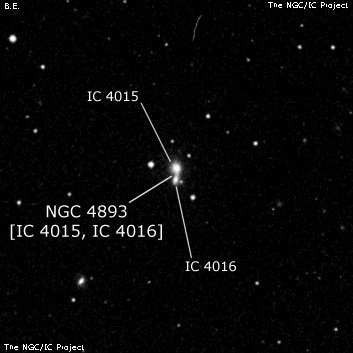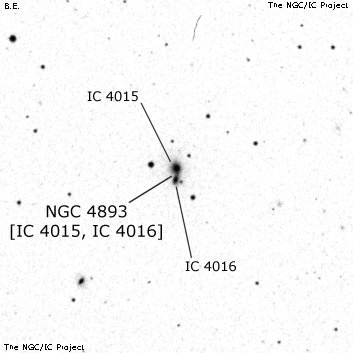NGC/IC Project Restoration Effort
(This is a very very beta version)
NGC4893


Basic Information
Location and Magnitude
Right Ascension: 12:59:59.6
Declination: +37:11:38
Constellation: CVN
Visual Magnitude: 14.3
Historic Information
Discoverer: d'Arrest
Year of discovery: 1865
Discovery aperture: 11.0
Observational
Summary description: vF, * 20 sp, * 17 nf
Sub-type: S?
Corwin's Notes
=====
NGC 4893 = IC 4015 and IC 4016, an interacting system. Neither d'A nor LdR
saw both objects here, though Dreyer himself described the object as "F, irr
R, E ns, rr" with LdR's 72-inch telescope -- he must have suspected that more
was going on here than just a single galaxy. Both Dreyer and d'A mentioned
the two nearby stars. Curiously, Dreyer adopted d'A's estimates of the stars
magnitudes in preference to his own: Dreyer called them 11-12 and 14, while
d'A has 17 and 20.
The fainter galaxy is often called "NGC 4893A" while the simple NGC number is
assigned to the brighter northen galaxy. It's not clear from the original
observations that this was the intent, so I've called the two galaxies
components of the NGC object.
The NGC position (from d'A's single observation) is far enough off the
galaxies that Wolf, in his fifth list, assigned the NGC number to a plate
defect.
Steve's Notes
=====
NGC 4893
24" (6/4/16): the two close components (IC 4015 and IC 4016) of NGC 4893 were resolved at 322x. The brighter northern component (IC 4015) appeared faint to fairly faint, small, round, 15"-18" diameter. The southern member (IC 4016) is faint, extremely small, round, 6" diameter. The centers of the two galaxies are separated by just 19". A mag 13.5 star is 44" E and a mag 15.0 star is just under 1' SSW. IC 4027, located 4' SE, is extremely faint, very small, round, 12"-15" diameter.
16" LX200 (4/14/07): faint, very small, round, 15"-20" diameter. A mag 13 star lies less than 1' E. This is a contact double system (IC 4015 + 4016 with a separation of 0.35'), though the components were not resolved. Located 11' SW of NGC 4914 and 82' SE of Cor Caroli (Alpha CVn).



